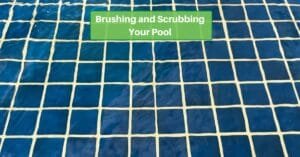A crystal-clear pool is a hallmark of a well-kept backyard. But stains can quickly ruin that polished look! A reddish smear on the floor, green blotches creeping along the walls, or chalky white crust forming around the waterline can all become frustrating parts of pool ownership.
Even with regular care, stains can pop up due to natural materials, water chemistry imbalances, or metal contamination. Ignoring them can lead to more stubborn buildup or even damage over time.
Fortunately, stains don’t have to be permanent. With the right approach, most can be identified, treated, and prevented in the future. The key is to understand what causes different types of stains and how to match your solution to the problem. Quick action and consistent upkeep can usually restore your pool’s good looks without needing major intervention.
Understanding the Types of Pool Stains
Not all stains are the same, and knowing what you’re looking at is the first step to fixing the problem. Pool stains generally fall into one of four categories: metal, organic, rust/rebar, and calcium scale. Each has its own distinct appearance and underlying cause, and each responds to a different type of treatment.
Metal Stains
These are some of the most common and frustrating. Metals like iron, copper, and manganese can enter the pool through fill water (especially if you use well water), corroded pipes, or even certain algaecides.
- Iron stains are usually reddish-brown or rusty blotches.
- Copper stains can be bluish-green or even black.
- Manganese often creates purple or dark brown marks.
You’ll typically notice metal stains along the pool floor or walls. They can be more obvious near return jets or steps where water movement slows down.
Organic Stains
Organic stains come from natural debris like leaves, berries, grass clippings, or algae that sit in the pool too long. They tend to be green, brown, or even bluish, and usually appear in irregular shapes or splotches. If you notice a stain that seems to fade when scrubbed or treated with chlorine, it’s probably organic.
Organic stains are most common after storms, under overhanging trees, or in pools that haven’t been cleaned for a few days.
Rust and Rebar Stains
These stains are more likely in gunite or concrete pools, where rebar or other metal components beneath the surface start to corrode. They typically appear as small orange or rust-colored spots that gradually spread over time. Unlike surface stains, these are caused by issues deeper in the pool’s structure, which may require repair to fully resolve.
Calcium and Scale Build-Up
Calcium build-up isn’t really a stain in the traditional sense, but they are worth mentioning. They show up as white or grayish crusts around the waterline or on steps and ladders. They’re rough to the touch and don’t brush off easily. The culprit is high calcium hardness or pH levels in the pool water.
Calcium scale isn’t just cosmetic. It can damage pool surfaces and equipment if you don’t treat it.
What Causes Pool Stains and How to Prevent Them
Identifying the type of stain is important, but understanding how it formed is what helps you prevent it from coming back. Stains may seem like random occurrences, most have very specific causes. They’re usually tied to your pool’s environment, water chemistry, or maintenance habits. Once you know what to watch out for, it’s easier to practice preventative steps.
Metals in the Water Supply or Equipment
One of the most common sources of pool stains is metal contamination. Iron and copper often enter the water through the fill source. This is generally more of a problem if you’re using well water or live in an area with older plumbing. Municipal water supplies can also have trace amounts of metals and they may build up over time.
Copper can also come from corroding heater components (especially if your pH is too low), or from copper-based algaecides. Iron and manganese may leach into the water if you’re topping off your pool frequently using well water or if your plumbing has rusted fittings.
How to prevent it:
- Use a metal sequestrant product regularly, especially after adding fresh water.
- Test your fill water before using it to see if pre-treatment is needed.
- Keep water chemistry balanced to prevent corrosion of metal components.
Organic Debris and Poor Circulation
Leaves, twigs, berries, and even grass clippings can introduce tannins and other natural compounds into the water. When they sit for too long on the surface or bottom of the pool, they may leave behind brown or green stains. Even algae can cause staining if it’s allowed to bloom and die off without proper cleanup.
How to prevent it:
- Skim debris after storms or windy days.
- Trim overhanging trees or bushes near the pool.
- Use a pool cover when the pool’s not in use for extended periods.
- Maintain good water circulation and sanitize regularly to avoid algae buildup.
Chemical Imbalances
Improper chemical levels are a major factor behind stains, especially those caused by scaling or metal precipitation. Low pH and low alkalinity can cause metal fixtures or heater parts to corrode, releasing metals into the pool.
On the other hand, high pH and high calcium hardness lead to scale deposits, which can trap dirt or metals and cause discolored buildup. Poor chlorine levels allow algae or bacteria to grow, both of which can leave stains behind even after they’re gone.
How to prevent it:
- Test water at least once a week, plus after heavy usage or rain.
- Aim for balanced parameters:
- pH: 7.4 to 7.6
- Total alkalinity: 80–120 ppm
- Calcium hardness: 200–400 ppm
- Free chlorine: 2–4 ppm
- Shock the pool regularly to maintain proper sanitation.
Poor Maintenance and Delayed Cleaning
Sometimes, stains happen simply because the pool wasn’t cleaned or brushed soon enough. When leaves or dirt settle on the bottom, they can stain if they just sit there. Even seemingly harmless toys, floaties, or equipment left in the water for days can cause discoloration, depending on the material.
How to prevent it:
- Brush and vacuum your pool weekly.
- Check behind ladders, steps, and corners where circulation is weak.
- Don’t leave plastic or metal items in the pool when not in use.
How to Treat Common Pool Stains: Step-by-Step Fixes
Once you’ve identified the type of stain and addressed its cause, the next step is removing it. Not all stains respond to the same treatment, and using the wrong approach can waste time—or worse, damage your pool surface. Here’s how to effectively treat the most common pool stains, organized by type.
Metal Stains (Iron, Copper, Manganese)
Metal stains often show up as reddish-brown (iron), blue-green (copper), or blackish (manganese). The most reliable way to confirm a metal stain is with a vitamin C tablet test. Simply press a tablet against the stain; if it lightens or disappears, it’s likely caused by metals.
Treatment:
- Lower the chlorine level to around 0–1 ppm. High chlorine interferes with metal treatment products.
- Adjust pH to 7.2 or lower to make the environment more acidic. This can help lift the stain.
- Use a stain remover made for metals, often ascorbic acid (vitamin C) for iron or citric acid for copper. These are usually added directly to the water or applied to the stain.
- After the stain is gone, add a metal sequestrant to prevent the metals from re-staining since they remain in suspension in the water.
- Resume regular chlorination and gradually raise pH and alkalinity to normal levels.
Important: Sequestrants don’t remove metals—they bind them in the water. If metals are persistent, consider partial draining and refilling with cleaner source water.
Organic Stains (Leaves, Berries, Algae)
Organic stains usually appear brown, green, or purple and may fade gradually. They’re typically treated with chlorine-based shock and brushing.
Treatment:
- Test and balance water chemistry, especially pH and alkalinity.
- Superchlorinate the pool using non-stabilized chlorine shock.
- Brush the stained area thoroughly using a pool brush.
- Run the filter continuously for at least 24–48 hours.
- Repeat the shock if staining remains.
For stubborn areas, apply chlorine granules directly to the stain and scrub gently, especially in plaster or concrete pools. Vinyl liner pools require more caution to avoid damage.
Scale and Calcium Deposits
White or off-white buildup along tile lines or rough patches on the floor are signs of calcium scale. These are not true stains; they’re actually mineral deposits and need to be dissolved or physically removed.
Treatment:
- Lower pH and alkalinity to slow further scaling.
- Use a scale remover product (acid-based) according to manufacturer instructions.
- Scrub scale with a pumice stone (plaster pools) or scale brush. Be gentle with vinyl or fiberglass surfaces.
- For tile lines, use a tile cleaner and scrub pad to safely remove buildup.
Prevent future scale with regular brushing, balanced calcium levels, and sequestrants if you have hard water.
Rust Stains
Rust spots are often small and round, caused by metal objects left in the pool or rebar bleeding through plaster.
Treatment:
- For minor surface rust from objects, remove the item and treat it like a metal stain (ascorbic acid).
- If rust is coming from beneath the plaster, it’s a structural issue that may require cutting out and patching the area.
Miscellaneous Stains (Swimmer Items, Pool Toys)
Bright-colored stains (like red or yellow) can come from pool toys, hair products, or swimsuit dye. These can be stubborn and unpredictable.
Treatment:
- Try a vinyl eraser sponge or soft scrubbing pad with mild cleaner.
- In some cases, oxidizing or enzyme cleaners may help break down the dye.
Always avoid abrasive materials on vinyl or fiberglass, and test any product in a small area first.
Long-Term Prevention: Keeping Pool Stains from Coming Back
Treating stains is useful, but preventing them saves you time, money, and frustration. With a few routine practices and seasonal adjustments, you can significantly reduce your chances of dealing with pool stains in the future.
Maintain Balanced Water Chemistry
Keeping your pool’s water chemistry within proper ranges is the most important factor in stain prevention. Imbalances can lead to scale buildup, metal corrosion, or organic growth. All of these create prime conditions for staining.
- pH: 7.4–7.6
- Total Alkalinity: 80–120 ppm
- Calcium Hardness: 200–400 ppm
- Chlorine: 1–3 ppm
- Stabilizer (CYA): 30–50 ppm
Regular testing (at least weekly during swimming season) helps you catch issues early.
Use Metal Sequestrants When Needed
If you know your source water contains metals—or if you’ve treated for metals in the past—it’s smart to use a metal sequestrant regularly. These products bind metal ions and keep them suspended so they don’t stain surfaces.
Add sequestrants monthly or after a fresh fill, and after heavy rains or water additions.
Keep the Pool Clean and Covered
Debris from trees, lawn clippings, and even bugs can introduce organics and minerals into your pool. If you let them sit, these materials break down and cause stains, especially in corners or on steps where water circulation is weakest.
- Skim and vacuum regularly.
- Empty skimmer baskets often.
- Brush the pool walls and floor weekly to disturb buildup.
- Cover your pool when not in use to minimize exposure to contaminants.
Watch for Problem Areas
Stains often show up in spots with poor circulation, such as corners, under ladders, or near steps. Give these areas extra attention during cleaning.
Also, inspect for small rust spots or discoloration around returns—early signs of metal or equipment-related issues. Addressing these early can prevent large-scale stains later.
Don’t Leave Items in the Pool
It’s tempting to leave pool toys, leaf rakes, or even floats in the water overnight—but many of these contain dyes or metals that can leach into the water and leave a mark. This includes seemingly harmless items like coins, hair pins, or swim goggles.
Encourage swimmers to remove jewelry, avoid products with heavy hair dye, and ask all swimmers to rinse off before entering the pool.
Pool stains are a common frustration for homeowners, but they don’t have to be a recurring problem. By understanding their causes, acting quickly when you see a stain forming, and committing to regular maintenance and prevention, you’ll keep your pool surfaces looking clean and inviting.
Whether it’s managing metal levels, brushing down walls, or being more mindful about what enters your water, a bit of consistent attention goes a long way. A clear, stain-free pool isn’t just more attractive, it’s also easier to care for and more enjoyable to swim in.









